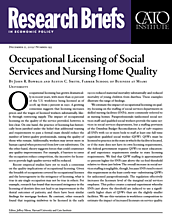Occupational licensing has grown dramatically in recent years, with more than 25 percent of the U.S. workforce being licensed as of 2008, up from 5 percent in 1950. A growing consensus suggests that licensing increases prices and the wages of licensed workers substantially, likely through restricting supply. The impact of occupational licensing on the quality of the service provided, however, is less clear. On one hand, the practice of licensing has historically been justified under the belief that additional training and requirements to pass a formal exam should reduce the number of lower-quality professionals, raising the quality of those who remain. Additionally, workers may invest more in human capital when protected from low-cost substitutes. On the other hand, theory suggests forces that could counteract any quality improvements. For example, if barriers to enter the occupation reduce competition, the incentive for licensees to provide high-quality service will be reduced.
Recent empirical studies have yet to reach a consensus on the quality implications of occupational licensing. Given the breadth of occupations covered by occupational licenses and the heterogeneity in the stringency of licensing, what is true in any single occupation may not be true in others. For example, research has found that increased stringency in the licensing of dentists does not lead to an improvement in the dental outcomes of patients; and there have been similar findings for mortgage brokers. By contrast, other research found that requiring midwives to be licensed in the early 1900s reduced maternal mortality substantially and reduced mortality of young children from diarrhea. These examples illustrate the range of findings.
We estimate the impact of occupational licensing on quality, focusing on the staffing of social services departments in skilled nursing facilities (SNFs), more commonly referred to as nursing homes. Paraprofessionals (unlicensed social services staff) and qualified social workers provide the same services in social services departments, but a staffing provision of the Omnibus Budget Reconciliation Act of 1987 requires all SNFs with 121 or more beds to staff at least one full-time equivalent qualified social worker (QSW). QSWs must be licensed to practice in the state in which the facility is located, or if the state does not have its own licensing requirements, the federal government requires QSWs to meet educational and experience requirements similar to state licensing requirements. We find that QSW staffing is approximately 10 percent higher for SNFs just above the 121-bed threshold relative to those just below. The overall increase in social services staffing is negligible, though, because SNFs tend to meet this requirement in the least costly way — substituting QSWs for unlicensed paraprofessionals. The regulation effectively increases the licensure level of the marginal social services employee. This policy creates a natural experiment whereby SNFs just above the threshold are induced to use a significantly higher share of QSWs than are the slightly smaller facilities. We use this variation in workforce composition to estimate the impact of increased licensure on service quality.
We find no evidence that the increase in licensure significantly improves overall facility quality, quality of life, or the provision of social services as measured by deficiency scores. Using the 95 percent confidence interval, we are able to bound any reduction in social service deficiencies to a narrow range. For a 10 percentage point shift from unlicensed paraprofessionals to QSWs, we see a maximum 0.2 percentage point reduction in the probability that a facility is cited for a deficiency related to the provision of social services.
These results should be interpreted in context, as a recent U.S. government report highlights the breadth of occupations that are currently licensed. For example, more than 1,100 occupations that range from lawyers to funeral attendants are licensed in at least one state. What is true for social workers may not be true for other occupations. First, an incremental change in licensure, as we see here, may exert a different influence on quality than would a complete overhaul of the licensing regime. Further, SNFs are in a highly regulated industry in which nurses and other types of licensed staff are required to be present. Even though an SNF may solely employ unlicensed paraprofessionals, the presence of other licensed professionals, and the fact that SNFs still face regulatory requirements to provide adequate social services, may dampen the effect of licensure of social workers when examining broad quality measures. Although further work is needed to examine whether social workers have an impact on areas of quality that are more difficult to measure, our results are consistent with the view that using QSWs instead of paraprofessionals does not broadly improve quality of care for patients in SNFs. In occupations for which quality is not already regulated, however, licensing may be more effective.
NOTE:
This research brief is based on John R. Bowblis and Austin C. Smith, “Occupational Licensing of Social Services and Nursing Home Quality: A Regression Discontinuity Approach,” ILR Review (June 2019), https://journals.sagepub.com/doi/abs/10.1177/0019793919858332.
About the Authors
John R. Bowblis and Austin C. Smith, Farmer School of Business at Miami University

This work is licensed under a Creative Commons Attribution-NonCommercial-ShareAlike 4.0 International License.
